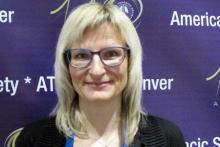DENVER – Pulmonary rehabilitation plus continuous positive airway pressure therapy improved pulmonary function, compared with CPAP alone, in a randomized study of 40 patients with obstructive sleep apnea.
While CPAP remains the main treatment option, it doesn’t address the obesity and inactivity levels that can contribute to comorbidities associated with OSA, Katerina Neumonnova, Ph.D., reported during a press briefing at an international conference of the American Thoracic Society. Patients with OSA often describe respiratory symptoms associated with diminished functional capacity and decreased health-related quality of life. Adjunctive pulmonary rehabilitation might improve pulmonary function, allowing for increased activity levels that can lead to improved outcomes.
Obstructive sleep apnea (OSA) improved with CPAP in all patients in the study. However, percent predicted vital capacity increased from 96.4 to 103.2 in the 20 patients randomized to receive pulmonary rehabilitation and CPAP, and decreased from 99.5 to 94.8 in the 20 patients who received CPAP alone. Percent predicted forced expiratory volume in 1 second (FEV1) improved from 91.5 to 96.1 in the pulmonary rehabilitation plus CPAP group, and decreased from 92.1 to 86.3 in the CPAP-only group.
Those who received pulmonary rehabilitation and CPAP also had significantly greater reductions in body mass index and in neck, waist, and hip circumference, said Dr. Neumonnova of Palacky University, Olomouc, Czech Republic. Percentage of weight as body fat significantly decreased in both groups, but the reduction was greater in those who received pulmonary rehabilitation (from 39.4 to 36.9) than in those who got CPAP alone (from 40.1 to 39.1), she said.
The patients, 20 men and 20 women, mean age 54 years, had similar baseline apnea/hypopnea index (greater than 15), pulmonary function, BMI, percentage of body fat, and neck, waist, and hip circumferences.
The 6-week pulmonary rehabilitation program consisted of twice-weekly 60-minute individualized exercise training sessions, combined with education, breathing retraining, respiratory muscle training, and oropharyngeal exercises. Patients were encouraged to steadily increase their levels of activity, measured by steps per day.
Dr. Neumonnova reported having no disclosures.

